Builders

They were built at the following plants:
| Derby Works | 160 |
| Beyer, Peacock and Company | 80 |
| Dübs and Company | 150 |
| Kitson and Company | 120 |
| Neilson and Company | 290 |
| Robert Stephenson and Company | 30 |
| Sharp, Stewart and Company | 85 |
| Vulcan Foundry | 20 |
The Midland Railway Johnson 0-6-0 were a class of locomotives serving Britain's Midland Railway system in the late 19th and early 20th centuries. Between 1875 and 1908 the Midland Railway, under the control of locomotive superintendents Samuel Waite Johnson and Richard Deeley, ordered 935 goods tender engines of 0-6-0 type, both from the railway's own shops at Derby and various external suppliers. Although there were many (mostly small) variations between different batches both as delivered and as successively rebuilt, all 935 can be regarded as a single series, one of the largest classes of engine on Britain's railways. The locomotives served as late as 1964, but none of them now survive.

They were built at the following plants:
| Derby Works | 160 |
| Beyer, Peacock and Company | 80 |
| Dübs and Company | 150 |
| Kitson and Company | 120 |
| Neilson and Company | 290 |
| Robert Stephenson and Company | 30 |
| Sharp, Stewart and Company | 85 |
| Vulcan Foundry | 20 |

The H and H1 boilers fitted to the "2736" and "3815" classes were larger, having a diameter of 4 ft 8 in rather than 4 ft 1 in, and a longer firebox, which made the engines more powerful. While these were being built there started a program of rebuilding many of the earlier engines (but not the first 2 classes) with the "H" boiler to increase their power. By 1915, 380 engines had been so upgraded, giving 450 with "H" and 485 with "B".
Beginning in 1916 engines were rebuilt with Belpaire boilers. Those from the first two classes ("1142" & "1357"), (none of which had received an "H") received the smaller "G6" type boiler (similar size to the "B"), the remainder the larger "G7" size (similar size to the "H"). The "H" & "G7" boilered engines were classed "3" (later "3F") and those with "B" & "G6" boilers were classed "2" (later "2F").
By 1925, production of the new superheated 4F 0-6-0s meant there was no shortage of goods engines of this power class, and from that point only "G6" boilers were installed on rebuilding, sometimes on engines which had previously had "H" boilers, reducing them back to class 2. Three of the later examples were experimentally fitted with superheaters from 1923 to 1928, but generally the class remained saturated throughout. One hundred and thirteen engines remained with their original "B" boilers until scrapped, 22 had "H" boilers, 432 had "G7" and 368 had "G6".
| Class | Pre-1907 numbers | Post-1907 numbers | Manufacturer | Date | Quantity built | Driving Wheels | Cylinders | Boiler | Notes |
|---|---|---|---|---|---|---|---|---|---|
| 1142 | 1142–1251 381–385, 400–404 | 2900–3019 | Kitson & Co. (30) Dübs & Co. (30) Beyer, Peacock & Co. (30) Neilson & Co. (30) | 1875–1876 | 120 | 4′ 10½″ | 17½″ × 26″ | B – 140 psi | [1] later had 18″ × 26″ cylinders; BR 58114–58187 |
| 1357 | 1357–1376 1432–1471 1582–1631 | 3020–3129 | Dübs & Co. (20) R. Stephenson & Co. (30) Beyer, Peacock & Co. (50) Derby Works (10) | 1878–1884 | 110 | 5′ 2½″ | 17½″ × 26″ | B – 140 psi | [2] later had 18″ × 26″ cylinders; BR 58188–58228 |
| 1698 | 1698–1717 1758–1797 | 3130–3189 | Derby Works | 1885–1888 | 60 | 4′ 10½″ | 18″ × 26″ | B – 140 psi | [3] |
| 1798 | 1798–1807 | 3190–3199 | Derby Works | 1888 | 10 | 5′ 2½″ | 18″ × 26″ | B – 140 psi | [4] |
| Neilson Goods | 1873–1972 | 3200–3299 | Neilson & Co. | 1890–1891 | 100 | 5′ 2½″ | 18″ × 26″ | B – 150 psi | [5] Collectively, the "1873" class. |
| J | 2023–2092 | 3300–3369 | Kitson & Co. (40) Dübs & Co. (30) | 1890–1892 | 70 | 5′ 2½″ | 18″ × 26″ | B – 150 psi | |
| J2 | 2133–2182 | 3410–3459 | Dübs & Co. | 1892–1894 | 50 | 5′ 2½″ | 18″ × 26″ | B – 150 psi | |
| M | 2093–2132 361–370 2259–2358 2391–2420 2461–2500 2541–2570 2641–2735 | 3370–3409 3460–3764 | Sharp, Stewart & Co. (85) Derby Works (10) Neilson & Co. (75) Kitson & Co. (50) Neilson, Reid & Co. (85) Dübs & Co. (20) Vulcan Foundry (20) | 1892–1902 | 345 | 5′ 2½″ | 18″ × 26″ | B – 160 psi | |
| 2736 | 2736–2740 240–244 | 3765–3774 | Derby Works | 1903 | 10 | 5′ 2½″ | 18″ × 26″ | H – 175 psi | [6] |
| 245–284 | 3775–3814 | Derby Works | 1903–1906 | 40 | 5′ 2½″ | 18½″ × 26″ | H – 175 psi | [7] | |
| 3815 | — | 3815–3834 | Derby Works | 1908 | 20 | 5′ 2½″ | 18½″ × 26″ | H1 – 175 psi | [8] |
The smaller driving wheels gave an enhanced tractive effort at the expense of reduced speed, which was useful on coal (and other mineral) trains.
| Numbers | Class | Weight | Boiler pressure | Driving wheels | Cylinders | Tractive effort |
|---|---|---|---|---|---|---|
| 2900–3019 | 2F | 40 tons | 160 psi | 4′ 10½″ | 18″ × 26″ | 19,420 lbf |
| 3020–3129 | 2F | 40 tons | 160 psi | 5′ 2½″ | 18″ × 26″ | 18,185 lbf |
| 3130–3189 | 2F | 40 tons | 160 psi | 4′ 10½″ | 18″ × 26″ | 19,420 lbf |
| 3F | 43 tons 17 cwt | 175 psi | 4′ 10½″ | 18″ × 26″ | 21,240 lbf | |
| 3190–3774 | 2F | 40 tons | 160 psi | 5′ 2½″ | 18″ × 26″ | 18,185 lbf |
| 3F | 43 tons 17 cwt | 175 psi | 5′ 2½″ | 18″ × 26″ | 19,890 lbf | |
| 3775–3834 | 3F | 46 tons 3 cwt | 175 psi | 5′ 2½″ | 18½″ × 26″ | 21,010 lbf |
Sixteen engines of the "M" class were bought by the Midland and Great Northern Joint Railway, eight in 1896 and eight in 1899, which were numbered 58–73. [9] All were built with Class "B" boilers (4 ft 3 in (1,300 mm) diameter over the largest ring, round-top firebox), and replacement boilers were normally of the same type; [10] but two (nos. 62 and 69) were rebuilt in 1906 and 1909 with the larger Class "H" boiler (4 ft 9+1⁄8 in (1,451 mm) diameter over the largest ring, round-top). [11] In 1921, two others (nos. 68 and 71) were rebuilt with the Belpaire Class "G7" boiler (4 ft 9+1⁄8 in (1,451 mm) diameter, Belpaire firebox) together with longer smokeboxes, which required the main frames to be extended at both front and rear. The two already fitted with Class "H" boilers received "G7" boilers and frame extensions in 1923 and 1928. [12]
All 16 were acquired by the London and North Eastern Railway (LNER) on 1 October 1936 and new numbers 058–073 were allocated, but five (nos. 63, 66, 67, 68, 72) were considered to be worn out and withdrawn in 1936–37, and three of these (nos. 66, 67, 72) did not receive their LNER numbers. The remaining eleven were added to LNER book stock in 1937 and classified J40 if fitted with the Class "B" boiler, or J41 if fitted with the Class "G7" boiler. [13] Withdrawal of these 11 began in 1938, and by the time that the LNER renumbering scheme was prepared in June 1943, there were five left, nos. 059, 064, 065, 070 and 071. [14] These were allotted numbers 4100–4, but none lasted long enough to be renumbered: the last, no. 059, was withdrawn in June 1944. [15]
Ten engines of "M" class were bought by the Somerset and Dorset Joint Railway in 1896 and 1902, numbered 62–66 and 72–76. All ended up with "G7" boilers and were taken into LMS stock as class 3F in 1930. The 10 locos were assigned odd numbers between 3194 and 3260 in other batches of the locos, which had become vacant due to withdrawals.
The class all retained their numbers when they passed to the London, Midland and Scottish Railway (LMS) at the 1923 grouping, but in 1934 2900–2984 (all class 2F) had 20000 added to their numbers to make way for newer locomotives. The same happened to 3000–3019 in 1947.
At nationalisation those that were class 3F, along with other LMS locomotives, had 40000 added to their numbers by British Railways, but the class 2Fs were reorganised into a new series 58114–58310. [16]
Withdrawal of the engines from service began in 1925, starting with unrebuilt engines, and continued until 1964. Despite the large number of locomotives of the class and their late survival, none were preserved.
No. 43222 hauled the Stephenson Locomotive Society's SM&JR railtour on 29 April 1956. It carried the reporting number M500. [19]
The London and North Eastern Railway (LNER) produced several classes of locomotive, mostly to the designs of Nigel Gresley, characterised by a three-cylinder layout with a parallel boiler and round-topped firebox. It produced the most famous locomotive of its day, 4468 'Mallard', the holder of the world steam locomotive speed record. It also built the world-famous 4472 'Flying Scotsman'. However, its locomotive inheritance was much greater than just the 'A4 Class', it also produced highly successful mixed-traffic and freight designs.
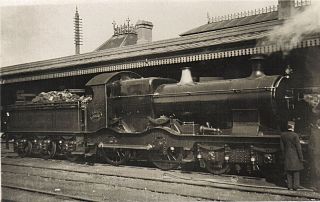
The Bulldog and Bird classes were double-framed inside cylinder 4-4-0 steam locomotives used for passenger services on the Great Western Railway. The Bird Class were a development of the Bulldogs with strengthened outside frames, of which a total of fifteen were built. A total of 121 Bulldogs were built new, with a further twenty rebuilt from Duke Class locomotives. Thirty Bulldogs were later rebuilt as Earl Class locomotives and renumbered 3265, 3200-3228.

The Midland Railway 1377 Class was a class of 185 0-6-0T tank locomotives. They were introduced in 1878 by Samuel W. Johnson, and were almost identical to the 1102 class of 1874; the latter having fully enclosed cabs, while the 1377 class were built without a rear to the cab and only a short cab roof, hence their nickname "half-cabs". They were given the power classification 1F.
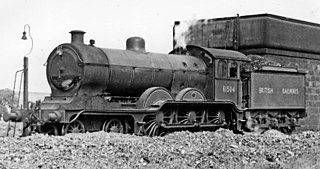
The Great Eastern Railway (GER) Class S69, also known as 1500 Class, and later classified B12 by the London and North Eastern Railway (LNER) is a class of 4-6-0 steam locomotive designed to haul express passenger trains from London Liverpool Street station along the Great Eastern Main Line. Originally they were designed by S. D. Holden, but were much rebuilt, resulting in several subclasses.

The GER Class L77, LNER Class N7, is a class of 0-6-2T steam locomotives. They were designed by Alfred John Hill of the Great Eastern Railway and introduced in 1915. The design was perpetuated by Nigel Gresley of the LNER after the 1923 grouping. 134 were built and one example is preserved.

The North Eastern Railway (NER) Class H, classified as Class Y7 by the London and North Eastern Railway (LNER) is a class of 0-4-0T steam locomotives designed for shunting.

The GER Classes S46, D56 and H88 were three classes of similar 4-4-0 steam locomotive designed by James Holden and A. J. Hill (H88) for the Great Eastern Railway.

The GER Class G58 is a class of 0-6-0 steam tender locomotives designed by James Holden for the Great Eastern Railway in England. The class consisted partly of new locomotives built from 1905 to 1911 and partly of rebuilds of the earlier GER Class F48 built from 1900 to 1903. The rebuilding started under GER auspices from 1921 and was continued by the London and North Eastern Railway (LNER) after grouping in 1923.

The M&GN Class C was a class of 4-4-0 steam tender locomotives of the Midland and Great Northern Joint Railway.

The North Eastern Railway (NER) Class Y 4-6-2T tank locomotives were designed whilst Wilson Worsdell was Chief Mechanical Engineer, but none were built until 1910 by which time Vincent Raven had taken over.

The Great Northern Railway Class H2 and H3 was a class of 2-6-0 steam locomotive designed for mixed-traffic work.
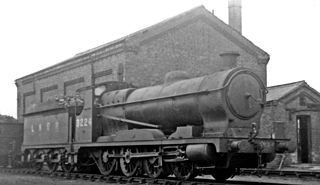
The Great Central Railway (GCR) Class 8A was a class of 0-8-0 steam locomotive built between 1902 and 1911 for handling heavy coal trains over the Pennines. They all passed to the LNER in 1923, who redesignated them Class Q4. They were withdrawn from service between 1934 and 1951.
Although overshadowed by the later and more famous steam locomotives that John G. Robinson would go on to design, the Great Central Railway Class 11B 4-4-0 Express Passenger engines were a successful class which totalled 40. Built from 1901 to 1903, in later rebuilt form as 11D, some 11Bs would last in service until 1950. Railwaymen continued to refer to the class as "11B" even after all were rebuilt to 11D. Being contemporary with and to some extent the 4-4-0 version of Robinson's much more numerous 0-6-0 goods class 9J, which were known as "Pom-Poms", the 11Bs acquired the nickname "Pom-Pom Bogies". The London & North Eastern Railway classified the 11Bs, along with their 11C and 11D rebuilds, as Class D9.

The NBR 224 and 420 Classes consisted of six steam locomotives of the 4-4-0 wheel arrangement built by the North British Railway (NBR) in 1871 and 1873. No. 224 had three claims to fame: it was the first inside-cylinder 4-4-0 engine to run in Great Britain; it was the locomotive involved in the Tay Bridge disaster; and after rebuilding in 1885, it was the only compound-expansion locomotive on the NBR, and one of just three tandem compounds in Britain.
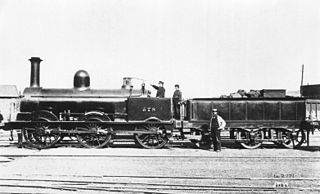
The London and North Western Railway (LNWR) DX Goods class was a class of 0-6-0 steam locomotive, designed by John Ramsbottom for freight duties. 943 were constructed, making them the largest single class of steam locomotives built in the United Kingdom. Despite this, none were preserved.

The Midland Railway Class 2 4-4-0 was a series of 12 classes of 4-4-0 steam locomotives built by and for the Midland Railway between 1876 and 1901 while Samuel W. Johnson held the post of locomotive superintendent. They were designed for use on express passenger trains but later on were downgraded to secondary work when more powerful types were introduced.
The NBR 141 Class consisted of two steam 2-4-0 locomotives built by the North British Railway (NBR) in 1869. They were the direct antecedents of the NBR 224 Class 4-4-0.
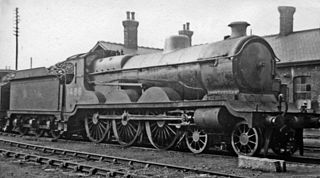
The GCR Class 8F was a class of ten 4-6-0 locomotives built for the Great Central Railway in 1906 by Beyer, Peacock and Company to the design of John G. Robinson for working fast goods and fish trains. They passed to the London and North Eastern Railway at the 1923 grouping and received the classification 'B4'.

The Midland Railway 1833 Class was a class of thirty 0-4-4T steam locomotives. They are sometimes included with the earlier 1823 Class or the later 2228 Class.

The NER Class V was a class of twenty steam locomotives of the 4-4-2 wheel arrangement. They were designed by Wilson Worsdell for the North Eastern Railway (NER) as express passenger locomotives.